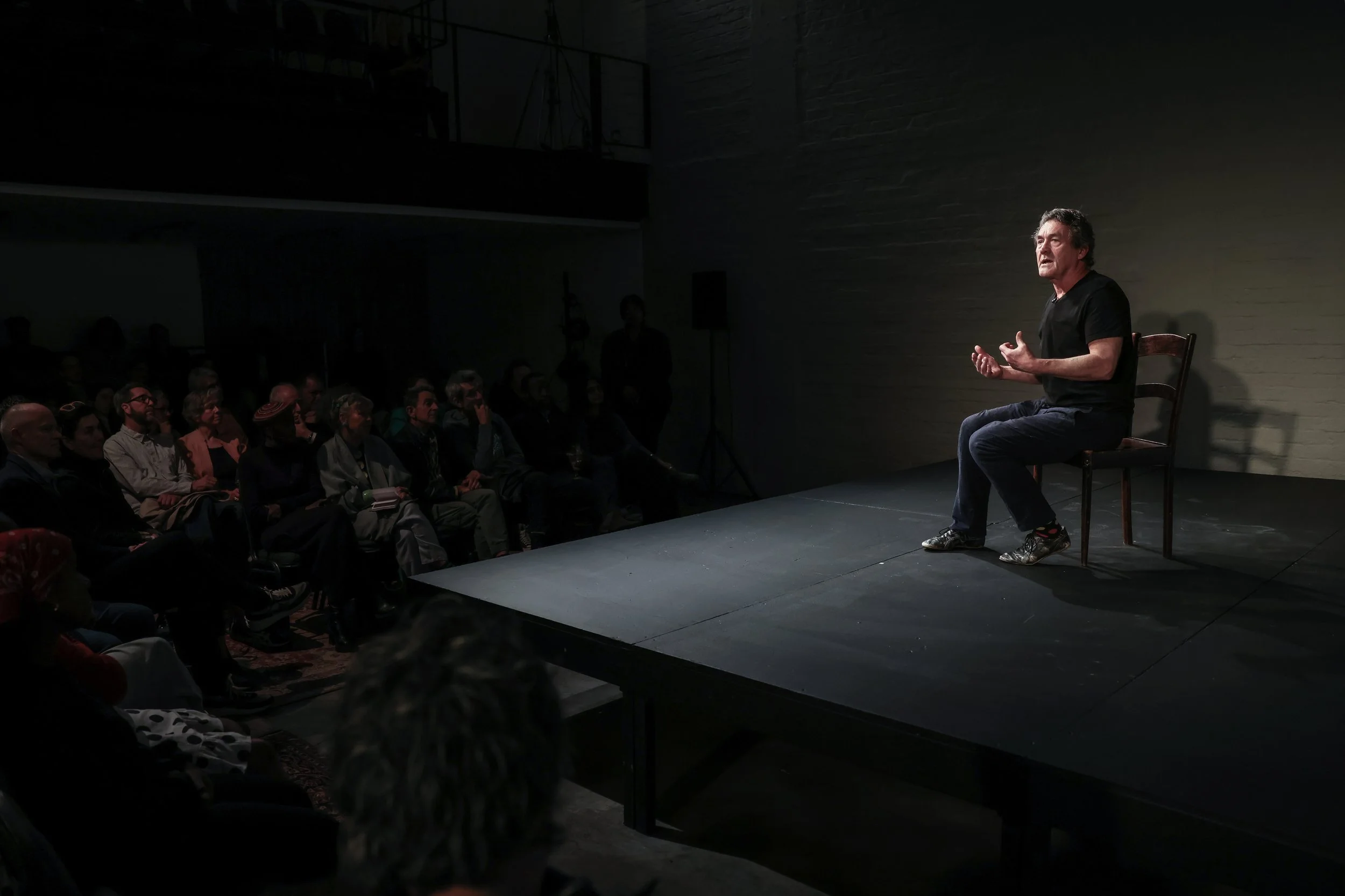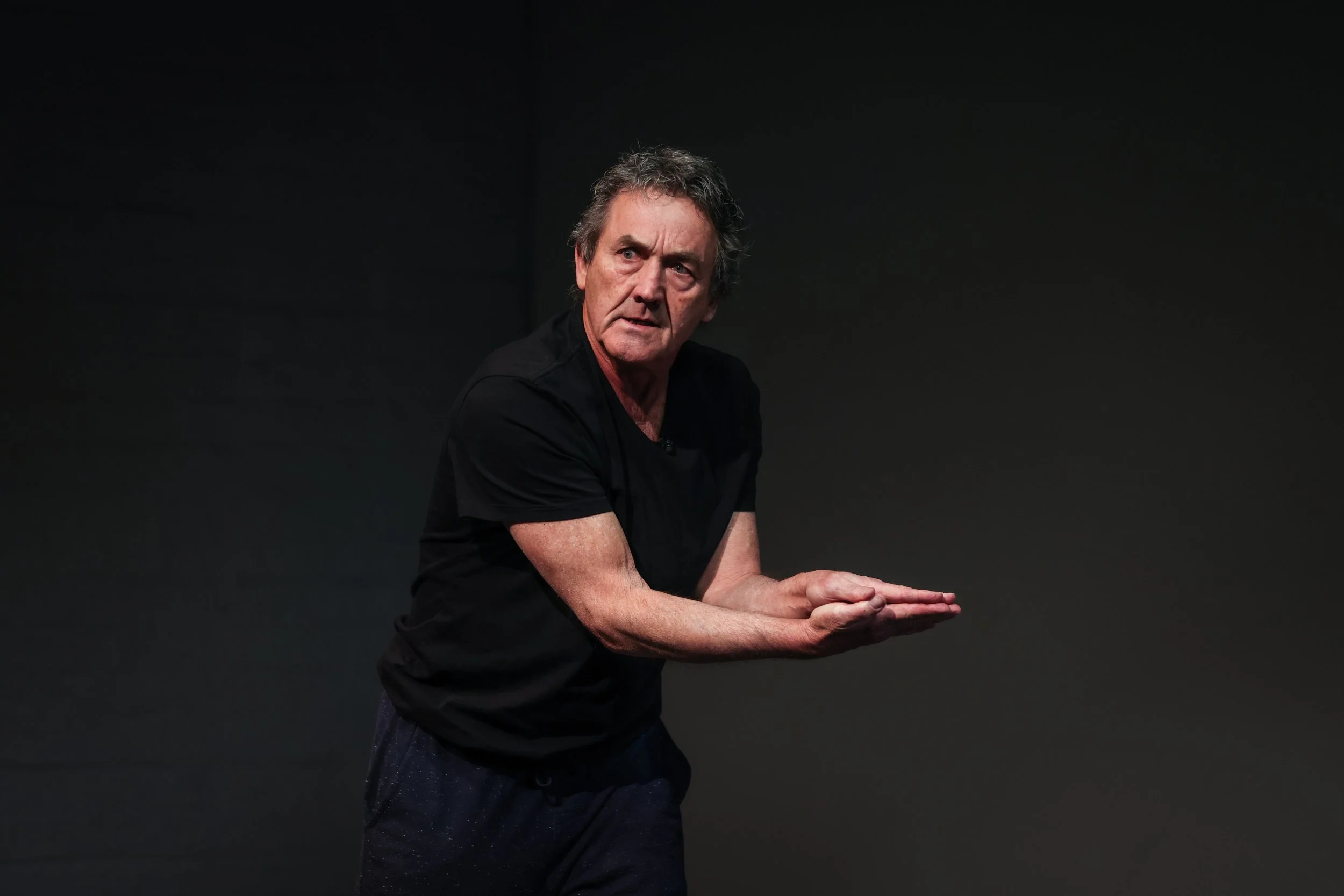HOW | SHOWING THE MAKING: ANDREW BUCKLAND
It begins with a low hum. Or perhaps a purring. It’s rhythmic, otherworldly. Slowly, a single spotlight rises to reveal a man who is wholly preoccupied with the act of mowing his lawn. He does this for some time, mowing this way and that, until he hits a snag and stops. “I have made a hole in the lawn,” he declares. “I had no idea it was so thin.”
So begins the journey into a rich, allegorical tale about fear, culpability, identity and truth in a time of great struggle and difficulty. When the otherwise ordinary man of Andrew Buckland’s The Ugly Noo Noo digs and descends into his suburban lawn, he begins to excavate not only his own identity, but the collective condition of a nation in emotional, political and humanitarian crisis.
On 13 August 2024, The Centre for the Less Good Idea presented HOW | Showing the Making: Andrew Buckland.
Following his successful run of The Ugly Noo Noo at Cape Town’s Baxter Theatre, and just ahead of his run at Johannesurg’s Market Theatre, Buckland presented this special HOW on the making and evolution of his iconic one-man performance.
The Ugly Noo Noo
Drawing inspiration from the irrational fear evoked by the Parktown Prawn, The Ugly Noo Noo delves into how fear is manipulated in times of struggle and difficulty, while also addressing universal human truths. The work, which has had a profound impact on South African theatre, was first staged in 1988.
Buckland’s HOW | Showing the Making gives audiences insight into the development of his signature style and the creation of The Ugly Noo Noo as a response to the political and social context of apartheid South Africa in the late 1980s. It’s also an opportunity to get a little closer to the thinking and strategies of this highly influential South African theatremaker.
As Buckland says about the inception of the work: “In 1988, the question for me was ‘How do I live my life?’ I was a white man living in a predominantly white, middle-class suburb with my little family in the middle of apartheid South Africa in a State of Emergency that was about to implode. I was concerned with the questions: ‘How can I live? How do I deal with the anxiety and with the conflict inside me and how do I transform?’”
Meaning takes place in the mind of the audience
“What seemed really important for me in the creation of the work, and something I gathered from my mime training, is that at the heart of it, at the essential core of performance and theatre – especially of mime – the action takes place in the audience’s imagination,” says Buckland.
Following a short showing of the opening scene of The Ugly Noo Noo, Buckland begins to break down the key moments of this scene, and how these performative decisions and methodologies resonate throughout the performance. Sound and gesture alone, he explains, can set up the conditions for a full and convincing world, into which the audience is invited to both reside and co-create. All that is required, then, is the body on stage, and an audience to perform with.
A dip into surrealism, fuelled by physicality
Much of the plot and narrative of The Ugly Noo Noo dips in and out of a surreal world. Following the lawn-mowing scene, explains Buckland, the protagonist finds himself cutting a hole into the lawn, which doubles up as a fleshy body of its own, and becoming trapped in a glass jar beneath the lawn. Bringing an audience along with him for these surreal turns, explains Buckland, relies on the use and consideration of the body on stage. But it’s also from this consideration of the body, that the surreal tone first emerges and becomes possible. Repetitive actions, gestures, and linguistic and performative paradoxes set up the conditions for surrealism to flourish.
“It was very much about trying to look internally and say well what is this conflict that I’m going through? How do I disentangle that or how do I try to understand? It was very much an inward journey,” says Buckland.
The power of physicality is also essential. Buckland cites his encounter with the work and teachings of Gary Gordon as highly influential in this regard. Gordon’s inclusion of physical performance training as a part of every student’s training, whether they wanted to pursue movement or not, was something of a revelation for Buckland. “The idea of the body as a key communicator just became inherent… understanding the power of physical embodiment to engage an audience in a non-literal way, a purely visceral way was made clear during that training with Gary.”
What then becomes essential is the understanding of what happens at the end of the physical action. Where does the audience go during the stillness after the gesture, explains Buckland. It is a way of being with the audience in order to generate empathy.
It’s called a practice for a reason
Above all else, keeping up with one’s training, and keeping one’s practice alive, is central to Buckland’s way of working. This, he explains, was another key moment in his early career and came from the advice of a colleague – a drummer who would practice for eight hours a day and then perform in the evenings.
“He said to me, ‘When do you practice?’ There’s a reason it’s called a practice, this art that you say you do. How do you take yourself seriously if you don't practice?’”
From then on, Buckland would spend his days practising – mime, voice, movement, writing – to hone his craft. Eventually, it became a way of refining his craft and a methodology towards creating new work, too. Constantly being in the act of moving, writing, and thinking, allowed his ideas to find a ready vessel.
Following a bit more history on the making of The Ugly Noo Noo and its relationship to the politics of the day, Buckland opened the floor to a host of questions, leading to further reflections on the grammar and expertise of the body in performance, theatre as a way of exercising the empathy muscle, and the process of trusting that the practice and the material will reveal the way forward.
— David Mann
CREDITS
PERFORMER | Andrew Buckland
MOMENTEUR FOR THE SO ACADEMY | Athena Mazarakis


